ASUS: The EN7600 GS Silent, and EN7800 GT TOP Silent
by Josh Venning on May 12, 2006 11:00 AM EST- Posted in
- GPUs
Overclocking, Heat & Power
We approached overclocking these cards with some caution because of what we mentioned before about heat issues. Since faster clock speeds equal higher temperatures on the GPU, more heat dissipation is needed, which can be a problem for cards with fan-less heat sinks. We found that the 7600 GS Silent did actually have trouble with overclocking, but interestingly, the Silent 7800 GT managed to achieve quite a high core and memory clock. Here are the clock speeds we achieved.| Overclocking Results | ||
| Core Clock | Memory Clock | |
| ASUS EN7800 GT TOP Silent | ||
| Default | 420 | 1240 |
| Overclocked | 481 | 1290 |
| % Increase | 14.5% | 4.0% |
| ASUS EN7600 GS Silent | ||
| Default | 400 | 800 |
| Overclocked | 442 | 874 |
| % Increase | 10.5% | 9.3% |
We tested these clock speeds by running the Splinter Cell Chaos Theory benchmark stress tests to verify stability. One thing to note is that these cards tended to get incredibly hot to the touch after several minutes of testing. Here are the performance results in Splinter Cell of the overclocked cards.
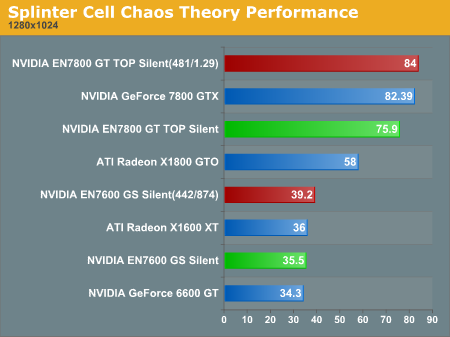

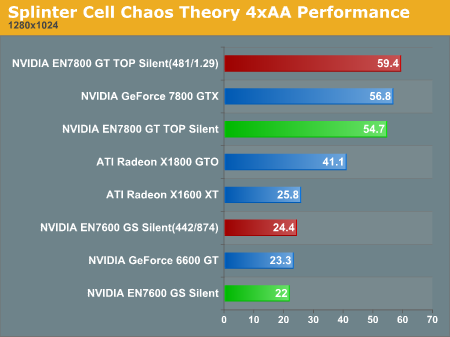
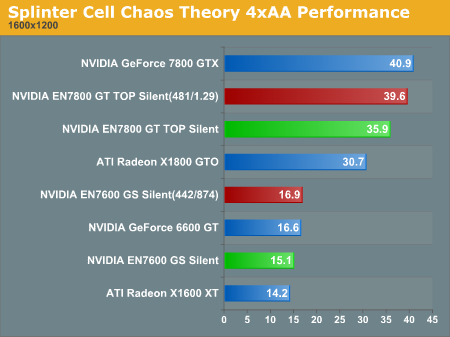
There's not much difference at all between the factory and user overclocked silent 7600 GS. This card was the worst of the two at overclocking and had a lot of trouble running stable (i.e. without graphical artifacts) during our stress tests. However, once we established the overclock of 442MHz/874MHz, the artifacts left and our tests ran cleanly. With the silent 7800 GT, the difference our overclocking makes is fairly significant. It did manage to boost performance by several fps, which may be a noticeable improvement during gameplay.
Power Consumption
We also tested the power consumption of these cards to see how much power they drew and if there was anything out of the ordinary. We acquired our power numbers by measuring the wattage of the total system at the wall outlet while idle and under load (stress tests). These are the results we recorded.
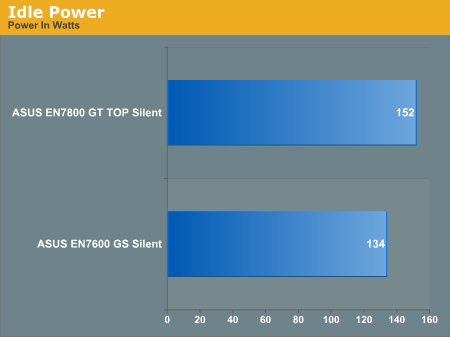
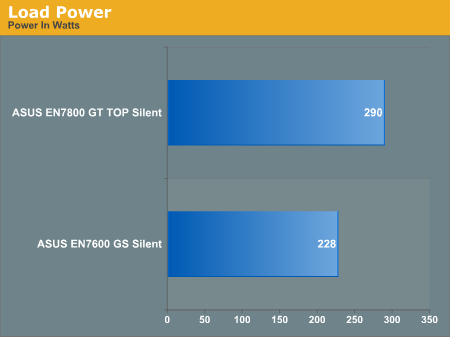
As expected, the EN7600 GS Silent drew much less power than the EN7800 GT TOP Silent. Neither of these cards are really power-hungry, but the fact that the EN7800 GT TOP Silent requires a 6 pin power connection reflects that its consumption is on par more with other cards of this type. The EN7600 GS Silent requires no external power connection, and its consumption is fairly low, which is good for those concerned with power draw.
Heat
We tested the temperatures of these cards as well to get a good idea of their heat levels generated during operation. We acquired the results here similarly to the power test, by taking the temperature of the GPU (in Celsius) while the system was idle and under stress testing. Here are the results.
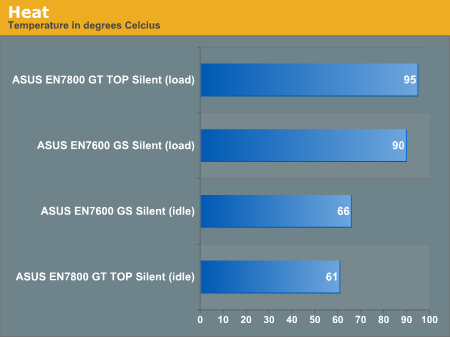
As we mentioned above, both cards do get very hot to the touch after running any 3D application for a bit. Something interesting here is that the EN7800 GT TOP Silent runs cooler at idle than the smaller EN7600 GS Silent. At load however, the 7800 GT gets about 5 degrees C hotter than the 7600 GS. The EN7800GT cooler is obviously larger and better at dissipating heat, yet the card still gets hotter because it is a much more powerful part.










39 Comments
View All Comments
Josh Venning - Saturday, May 13, 2006 - link
Thanks Jarred.Yes the Splinter Cell graphs were wrong for most of the EN7600 GS Silent results. I went back and changed them so the graphs are now accurate. Sorry for the confusion here.
poohbear - Friday, May 12, 2006 - link
lol wow jared u actually answered the jerk's post in a professional manner. some teenager rants and raves in the manner befitting a 15 year old, and u answer him like he's an adult. gj mate.Griswold - Friday, May 12, 2006 - link
Asus needs to bring us a 7900GT with that cooling solution. It should be much better than the 7800 in terms of heat output.nullpointerus - Friday, May 12, 2006 - link
It would be better to get a 7900GT ($290) and an Accelero X1 ($35). There is almost no discernable difference between silent and nearly silent, but the thermal difference is going to be HUGE. A large (i.e. 120mm) fan will thoroughly trounce the stock coolers while producing next to zero noise. Why pay $400 for a passively cooled 7800GT?nullpointerus - Friday, May 12, 2006 - link
Oops, slight error. The Accelero series won't have a 7900GT-compatible model until June, so you'd have to use a 7800GT instead.yacoub - Friday, May 12, 2006 - link
Friggin' 7800GT TOP-SILENT came out a year ago. Time for a 7900GT TOP-SILENT already, WTF!! >:[Griswold - Friday, May 12, 2006 - link
Not quite. It first popped up on Asus' website in november or december of last year.yacoub - Monday, May 15, 2006 - link
way to miss the point: IT'S OLD. IT'S LAST-GEN HARDWARE. oh and IT RUNS WAY TOO HOT.BurntKooshie - Friday, May 12, 2006 - link
If I understand the article correctly, this means the CPU fan is drawing in hotter air (because the air has pass over the extended heatsink). If correct, why didn't you test to see the effect of the newly obstructed and hotter airflow upon CPU temperature?rowcroft - Friday, May 12, 2006 - link
I've been looking at an SLI setup for 4 DVI ports, would the GT TOP work in SLI? I'd be concerned about where the second rotating heatsink would go.